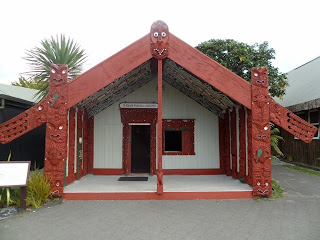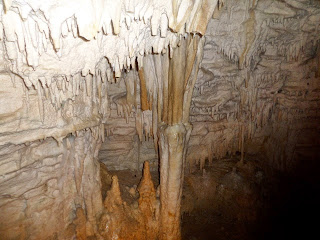We stayed in Matamata on Monday because of its close location to Hobbiton the movie set for The Lord of the Rings trilogy and the Hobbit films. Admittedly, being a big LotR fan, Louise was more excited about this than I was. I liked the LotR films but haven't read the books although I did enjoy The Hobbit book when I was younger, but haven't seen that set of films. However, it is always interesting to visit film sets and see how everything was created and brought to life from imagination. Hopefully this would have made Tolkein proud and we definitely felt as though we had been transported to The Shire in Middle Earth.
Hobbiton was incredible. So much detail has gone into each part of the set and just looking around at the many hobbit holes it is not difficult to imagine hobbits roaming around inside them. All the hobbit holes are different sizes so that scenes could be filmed making certain characters look taller or shorter, playing with the audience's perspective to make the film more realistic. Only one hobbit hole is 100% to scale on the whole set.
Below are some of the many photos I took from the tour. As you can probably tell I was snap happy and it was difficult narrowing down my 100+ Hobbiton photos. Whilst walking around the set we were told interesting facts about Hobbiton and the filming of the movies, some of which I have shared with the photos.
Hobbiton was built originally for the LotR movie trilogy brought to life by director Peter Jackson. Originally he wanted to make two films but the company, Miramax, he first took it to disagreed with him due to financial reasons and wanted one film. Jackson spent nearly four weeks travelling around Hollywood trying to sell the idea of two films, before meeting with New Line Cinema. It was here that it was suggested that three movies were made as the book was released in three volumes. Obviously this was an offer that could not be refused and the creation of Middle Earth was underway.
Fake smoke pouring out of one Hobbit's chimney. I believe steam was used instead.
The ideal land for the Hobbiton set was found by location scouts after flying over it in a helicopter. When they first approached the family that owned the farm to have a look around they accidentally interrupted a rugby match on TV and were asked to come back later. Instead the scouts got permission to have a walk around the land before leaving. Nothing was said until about 6 months later when the family who owned the land were asked if it could be used for filming.
The family had never heard of the LotR books but agreed to the use of their farm anyway. It was perfect for the location scouts as there was no man made features apart from one building which was disguised by trees. The fences were redone to fit in with the style required for the film but beyond this there were no major changes.
This short ladder was adorable.
The New Zealand army was brought in to help clear the land and get it ready months before filming began. This was to allow for the plants to grow giving the land the gritty realism that Jackson had envisioned for the films. The family were sworn to confidentiality and so they told their neighbours that the army was using the farm land for training.
Bilbo Baggin's home is described as being under a tree in the book, which is shown in the photo above. However, this tree is fake as there was not one naturally occurring in the landscape. To create the artificial tree a real oak tree was cut down and reassembled on site. Thousands of hand painted leaves were imported from Taiwan to be attached to the tree to make it look alive, all for a couple of minutes on the silver screen.
When the time came to film The Hobbbit the leaves had either fallen off or become bleached and so the tree was rewired. Unfortunately, just before filming Peter Jackson became ill and could not work on the set. When he finally came back he decided that the leave a were too bleached and that they all needed to be repainted before filming started!
As can be seen there are stunning views of rolling hills as the backdrop of Hobbiton. It was on this land that the farmers sheep used to graze. However, during filming they had to move a total of 12,000 sheep that were popping up in the fields in the background.
This is the Green Dragon Pun from the books and it is absolutely fantastic. The attention to detail is amazing from the Hobbit coats and hats hanging on the walls to the posters and advertisements which adorn the walls. The original pub was burnt down during the filming process for one of the movies. The one that stands at Hobbiton today is a replica with painstaking attention to detail, so much so that it appears almost identical to the first. It was here we got to have a free Middle Earth cider, ale or ginger beer to complete our tour.
All three of the LotR films were shot in one go on the land and the intention was to demolish the movie set after use and it was only built of temporary materials for this very reason. However, a storm in the winter halted the destruction process and it was during this time that the family who owned the land could finally tell their neighbours what had been going on.
Many were curious and wanted to have a look at the remains of the set. Following this, the idea of leaving the 18 remaining hobbit holes and giving guided tours was developed. Additionally, it transpired that the films were hugely successful. This was lucky for both the family who were starting to operate tours and Sir Peter Jackson, the director, who would have had two extra unwanted films if the first one had been a flop.
Various permissions were sought and paperwork completed to allow the family to operate tours with no legal repercussions. When the film company wanted to film The Hobbit they again requested use of the farm. It was agreed on the condition that they make the set permanent out of lasting materials so that any visitors could see Hobbiton in full. It was agreed and today there are around 40 hobbit holes dotted across the hill sides creating the perfect image of a cute, cosy village; an incredible film set.
After tearing a besotted Louise away from Hobbiton it was time to drive to Rotorua. We didn't actually make it into the town centre as we were just driving past on our way to Taupo but we stopped at the Te Puia Geothermal Park to have a look around.
Geographically New Zealand is an extremely interesting country sitting on tectonic plates. Therefore it is volcanic, earthquake prone and full of geothermal activity. Rotorua is a prime example of this as it sits on the Rotorua Caldera meaning there are geysers and hot mud pools in the area. There is also an extremely strong sulphur smell which can be a little suffocating at first.
The long and unpronounceable name.
In addition to being a geothermal park, Te Puia is an area dedicated to Maori tradition and history. Tours educate guests in Maori customs and our lovely guide, who called us family from the beginning, was more than happy to share aspects of her life and culture with us.
The stone above is called greenstone, Pounamu in Maori, and is important in Maori tradition as it is considered a treasure. It increases with prestige through generations and therefore the eldest are often the most prized. It is often given to others but you should never buy it for yourself, it should be gifted.
Above are photos of the present day meeting house which is used by the Maori community.
These two photos are of the original and much smaller meeting house. Intricate carvings adorn the walls as well as photos of previous leaders and important people.
A storage house for food and other perishables. The stilts are meant to raise it from the ground and therefore away from theiving animals.
Carvings and beautiful woodwork is another part of the Maori life as they use it for decoration and for telling stories through, allowing them to be passed through generations. Interestingly, it is only recently that Maori has become a written language. At Te Puia there is a carving and weaving school.
Above are the extremely beautiful geysers, an incredible natural formation which look exquisitely beautiful in the grey landscape, causing a colourful rainbow. It is the angry, rolling clouds that I loved when we were there and in these photographs. Watching the geysers was magical and our guide timed it perfectly as they only 'blow' like this every couple of hours. In fact, the first geyser in the photos, furthest to the left of the photo, hardly ever blows so we were extremely lucky.
The hot mud pools were continuously bubbling, popping and exploding liquid mud which made for an interesting sight.
We left Te Puia to carry on our merry way with around an hours worth of driving left. The journey to Taupo was packed full of beautiful scenery and it was a pleasure to drive along the winding roads drinking it in.
We arrived in Taupo in the early evening and quickly stopped at a viewpoint just north of the great Taupo Lake before driving through the small town to our hostel. We had a relaxed evening with some take away pizza and getting some rest before the drive to Wellington the following day.
Until next time.
A x





















































